The new site took over the whole of the catalogues etc. of the old site, and below is a small part of the old site which was not transferred as such.
This is hence both a legacy and reminder of where it all began . . .
VICTORIAN SILK.com
featuring known silk bookmarks, silk pictures and silk postcards manufactured since 1862

Stevengraph silk bookmark - Victoria Jubilee
Below is a list of the content sections available on our sister web site:
www.Stevengraph-Silks.com
| Stevens Silk Pictures | |
| Stevens Silk Portraits | |
| Stevens Silk Bookmarks, Ribbons and Lapel Pins | |
| Stevens Silk Postcards | |
| Stevens Souvenir Silks | |
| Stevens Other Silk items |
Grant
| Grant Silk Pictures | |
| Grant Silk Portraits | |
| Grant Silk Bookmarks, Ribbons and Lapel Pins | |
| Grant Silk Postcards | |
| Grant Rosettes & Other Silk Items |
STEVENGRAPH as a title was invented by Thomas Stevens and first appears on the backing paper for his bookmarks in 1876. He called his factory "The Stevengraph Works", and later referred to his woven silk pictures in the same way when they first appeared in 1879.
It is perhaps only in the last few years that the Stevengraph title started to be applied to all the silks produced by other Victorian silk weavers, and also extended to include all woven silk items, no matter who made them or when.
In the late 1800's, the silk ribbon weavers of Coventry, England, were experiencing very difficult trading conditions due to changing fashions and cheap imports from abroad. Several weavers had already diversified into related activities, and Thomas Stevens was one of these, with his Stevengraphs.
Hello, and Welcome
Thank you for visiting and please enjoy the short article below relating to Thomas Stevens and his woven silk pictures and bookmarks.
Once you have finished reading, and wish to follow up on the topic, please visit our sister web site. You can see on the pane to the left all the sections covered in the web site www.Stevengraph-Silks.com.
Each of these sections have extensive and comprehensive detailed alphabetic catalogues of titles, together with quality images to support these titles. As well as the Victorian silk weavers of Stevens, Grant, Bollans and Welch & Lenton, there are the modern weavers such as Brocklehurst-Whiston and Brough, Nicholson & Hall etc..
J. & J. Cash
| J. & J. Pictures | |
| J. & J. Bookmarks | |
| J. & J. Greeting Cards | |
| J. & J. Other Woven Items |
E. Bollans & Co.
John Caldicott.
R. Barton.
Dalton & Barton.
Welch & Lenton.
Brough, Nicholson & Hall.
Brocklehurst-Whiston (BWA)
Other weavers:-
Bradbury, Greatorex Beall
R. S. Cox & Co.
Darlinson & Barton.
G. Holme.
Alice and Samuel Kilmer.
Lester & Harris.
J. Matthews.
Mellor Bros.
Morgan & Scott Ltd.
Mulloney & Johnson.
Charles Newsome.
W. Perkins.
J. Pratt & Sons.
John Rogers.
Thomas Skillcock.
Henry Slingsby.
H. Spencer & Co.
Webster & Butterworth
James Wilde & Son.
E. Wilson.
Useful Links, including Stevengraph Collectors Association
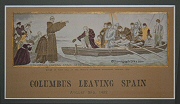
Stevengraph woven at the World's Columbian Exposition, Chicago 1893, titled Columbus Leaving Spain

J J Mannion silk picture attributed to Thomas Stevens
THE AWAKENING INTEREST IN STEVENGRAPHS
The most extensive and comprehensive study of Thomas Stevens and his Stevengraph silks must be the 1971 book by Geoffrey Godden: "Stevengraphs and other Victorian silk pictures".
I thought it might be informative to extract parts of Chapter 1 of that book, and reproduce them below. Permission has of course been obtained from both Mr Godden and the copyright holder to permit this extract.
Table of Contents:-
Stevengraphs in America
Thomas Stevens - The Man
The Machinery - Joseph-Marie Jacquard's loom
The Designers
Marketing
The Stevengraph Silk Bookmarks
The Stevengraph Silk Pictures & Portraits
Stevens Heritage
Copyright
Stevengraphs in America
Although an article on Stevengraphs was published in the American magazine Antiques in March 1933, and the author, Mary Dunham, had collected her silks in England before this date, it is true to say that until the 1950s there was very little interest in Victorian objects. They excited little sympathy and often suffered ridicule; and so our silk-work pictures were unjustly neglected with a mass of other now highly collectable material.
It is probable, however, that there were a few discerning people quietly collecting them for their decorative charm. Although such buyers were in the minority the revival of demand and the appreciation of these Victorian novelties probably started in America.
It must here be stated that Thomas Stevens had always enjoyed an export market for his silks, for many were sold in Europe and may be found with German and French titles on the card-mounts. He also cultivated the American market, and Stevens labels may be found bearing the names and addresses of American agents.
Thomas Stevens, having first introduced and sold his Stevengraph pictures at the York Exhibition of 1879, always had a great interest in such events and issued several special pictures commemorating these exhibitions. One finds silks depicting the Edinburgh International Exhibition of 1886, the Manchester Royal Jubilee Exhibition of 1887 and the Glasgow International Exhibition of 1888.
He carried this scheme to America, for he had looms in the Chicago Exhibition of 1893 where special subjects such as LANDING OF COLUMBUS and its companion COLUMBUS LEAVING SPAIN were woven and are to be found with the wording, 'Woven in pure silk at the World's Columbian Exposition, Chicago, 1893' printed under the picture.
Thomas Stevens also had several agents in America. One of the foremost of these was J. J. Mannion & Co., of Cincinnati, who printed their own name on the card-mounts in place of the normal credit to Thomas Stevens of Coventry.
It is clear, therefore, that Stevengraphs were well known in America in the later part of the nineteenth century, and that many must have remained in the possession of descendants of the original owners or have become available on the market to foster the interest of recent collectors.
This situation led to the publication in America, in 1957, of Mrs Wilma Sinclair LeVan Baker's The Silk Pictures of Thomas Stevens, a book that was the result of the author's seeing in her married son's home four Stevengraphs gracing the living-room. Later, she found four more in a shop in Cape Cod and purchased them, originally as a gift for her daughter-in-law; but on the way home she decided to keep them herself to start her own collection. This led to years of research into their history and, ultimately, to the publication of her pioneer book.
Its appearance naturally stimulated curiosity about these neglected Stevengraphs at a time when there was a growing interest in America in Victorian antiques, especially when they were of British origin. As a result, there were soon too few Stevengraphs to satisfy the demand among the new American collectors and, consequently, dealers started buying them in England.
This American demand soon became common knowledge - at least amongst dealers - as a result of the circulars and advertisements, with the natural result that the English dealers showed a new interest and several began to specialise in Stevengraphs and to advertise their own requirements.
During the 1950s, when I was newly connected with the family antique business, we did have in stock some examples which were probably parts of 'mixed-lots' bought at auction sales. I remember that these hung fire for many years, nobody showing the slightest interest in them, until one day in the early 1960s an American buyer, and a friend of long standing, purchased the five or six we had available.
Having sold our 'stock' of Stevengraphs, we heard nothing more about them and I concluded that this was one of our suggestions that had fallen on stony ground. However, a year or more later, our friend was writing for 'more of those little silkwork pictures you sold me some time back'. Needless to say, in the interval their growing popularity had become more widely known, with a consequent increase in price.
In America, in October 1965, was formed the Stevengraph Collectors' Association, whose origins go back to 1937, when the Founder and President of the Association, Mr Lewis Smith, had been given a Stevengraph of one of the decorative but fairly common horse-racing scenes. Then, while honeymooning in Nassau, he had found more silk pictures, which prompted him to carry out research.
At that time, the only source material available had been the article by Mary Dunham in the March 1933 issue of the Antiques magazine. He subsequently corresponded with Miss Dunham and purchased her collection; and he has, over the years, built up a magnificent collection which is believed to be the largest and most varied in the world.
It must not be thought that all interest in Stevengraphs stemmed from America. I have, indeed, already stated that there were a few early collectors in England; but, in general, they were persons collecting items for their decorative appeal rather than as a close study - and such collectors could get little or no information about the history of the silks, as they were not mentioned in the reference books dealing with antiques.
A chapter in Mrs Therle Hughes' book More Small Decorative Antiques, published in 1962, seems to have been the first effort by an English author to give detailed information on Thomas Stevens silk-work pictures and book-markers.
In July 1963, in The Daily Telegraph 'Peterborough' feature 'London Day By Day' included an illustration of a Stevengraph in reporting an early commercial exhibition of these silk pictures at the gallery of Messrs Frank T. Sabin in London. 'Peterborough' noted with interest that these once shilling silks were priced at eight guineas. Since then, of course, priced have climbed - or rather rocketed - so that rare subjects fetch well over £100.
Quite apart from the actual sales, the publicity that these engendered was of the utmost importance. 'Record prices' for Stevengraphs began to be reported in the national Press, and several articles appeared in trade and collectors' magazines.
In the latter part of 1968, the second book on Stevengraphs and book-markers appeared under the joint authorship of Austin Sprake and Michael Darby. Their book, simple entitled Stevengraphs, was published privately in a limited edition, so that its sale was to some extent confined to already established collectors. Nevertheless, its publication marked another notable milestone in the revival of interest in these silk pictures.
Many readers will, no doubt, be asking where we go from here. Will the interest gain further momentum? Will prices increase further? Will Stevengraphs prove to be a good investment?
Nobody can answer these questions with certainty; but past experience in other collecting fields suggests strongly that in all cases the answer will prove to be in the affirmative. The key is contained, once again, in the balance - or, rather, imbalance - between supply and demand. Obviously, the more the demand outweighs the supply the higher will rise the price.
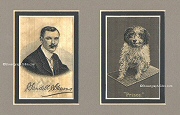
Portrait silk of Thomas Stevens' grandson, Sandell Stevens, mounted with his the terrier dog 'Prince'.
Thomas Stevens - The Man
A little must also be said about Thomas Stevens himself.
It is unfortunate that little is recorded about his life, and the standard reference books do not include the name of this Coventry manufacturer.
Facts gleaned from his obituaries show that he was born in or about 1829 at Foleshill, a village near Coventry, and that he had three brothers - Henry, James and John - and three sisters.
The official 1861 census returns list the family at 32 Queen Street, Coventry (the address shown on early book-marker mounts), as follows:
| (born at) | ||||
| Thomas Stevens | aged 31 | Ribbon manufacturer | Foleshill | |
| Anne Stevens | 30 | Huddersfield | ||
| Liggie Stevens | 6 | Scholar | Coventry | |
| Annie Stevens | 3 | " | ||
| Harry Stevens | 11 months | " | ||
| Mary Rogers | 15 | House servant | " |
In his teens, Thomas Stevens worked for Messrs Pears & Franklin, ribbon-weavers; but in 1854 he started on his own account at 32 Queen Street, Coventry. This venture seemed to have been successful, but it must have been badly hit in the early 1860s with the general slump in the silk-weaving industry due to the flood of inexpensive duty-free Continental products that were being imported to the British Isles.
These dark days in Coventry were, however, the cause of Thomas Stevens' rise to fame - for, as I have explained, he turned his idle looms to the production of silk-woven book-markers (sold through bookshops and stationers) and later adapted the idea to the production of mounted pictures, not only in Great Britain but also in America and on the Continent; ironically, the source of the competition that forced him to introduce the novel book-markers in 1862.
His drive and initiative, and his success in selling his wares in foreign markets, would surely have warranted a Queen's Award to Industry if such a scheme had been introduced in his lifetime.
He died in London on 24 October 1888, only two years after the first of the series of portrait silks had been introduced.
His sons Thomas and Henry continued the Stevengraph Works and introduced many new subjects. In short, they continued the traditions so well founded by Thomas Stevens; and although several competitors entered the field, none could approach the quality and charm of the true Stevengraphs.

Joseph-Marie Jacquard's loom, as modified by Thomas Stevens
The Machinery - Joseph-Marie Jacquard's loom
It is only right that a few details should be given about Joseph-Marie Jacquard, for the Stevens silks were woven on adaptations of his famous loom - which was, according to The Encyclopaedia Britannica, ";the most important invention ever applied to the hand-loom . . ."
Jacquard was born in Lyon, France, in July 1752. He worked in a local factory, employing his spare time in constructing an improved type of loom - for silk-weaving was the local industry. An early model was exhibited in Paris in 1801, and by 1812 there were over 10,000 Jacquard-type looms in France.
So important was the introduction of these machines to the French silk trade that the new looms were declared public property, although Jacquard received a royalty on each machine and was granted a State pension. After his death, in August 1834, a statue was erected in his honour in his native city of Lyon.
The fame of his looms soon spread outside France. One of the main points about the loom was that the reproduction of a given design was automatically achieved and controlled by punched cards. Once these master cards had the holes punched correctly and fed into the loom machinery, the woven-silk design was reproduced in identical fashion until the machine was fed with new punched cards.
I have fortunately been able to gather a first-hand impression of the method of manufacture of the Stevengraphs. This interesting account was written for me by Mr G. S. Hill, a former Managing Director of Thomas Stevens (Coventry) Ltd.
He writes:
To produce a silk-woven picture the following is the routine:-
- A coloured painted sketch is prepared to the exact size in which the article is to be woven. This would be entrusted to one artist who would probably need two to three days to complete the sketch to his satisfaction.
- The next stage is the enlarging of the sketch on to point paper - firstly by putting in the whole of the design in pencil and then painting in an exact reproduction of the colours to be woven. This produces a 'draft' about ten or eleven times the size of the original sketch and shows every single thread in the ribbon coloured as it is intended to weave. This could take a designer seven to ten days - very close and trying work.
- When the draft has been completed and carefully checked, Jacquard cards are cut for weaving the pattern. This is a slow process and calls for great concentration as a separate card has to be cut for every weft thread in the design.
- When the cards have been cut and assembled in correct weaving order they are laced together.
- The cards are then placed on to the Jacquard machine, on top of the loom which, when the various shuttles are filled with the correct weft thread colours, can then start weaving.
First-hand Victorian accounts relating to the manufacture of these silks are extremely scarce, but one description published in the North British Daily Mail of 25 October 1888 relates to Stevens' loom working at the Glasgow Inter-national Exhibition:
Mr. Thomas Stevens has a rather peculiar looking Jacquard loom, which is constantly attended by a crowd of onlookers while at work. It weaves, in silk, portraits, book-marks, pictures of the Exhibition, and other pictures. These pictures and portraits are woven in strips of about six inches broad, of which twelve are woven at one time, and the speed with which the pictures seem to grow under the fast 'click click' of the travelling shuttle is always a matter of astonishment to visitors. . . .
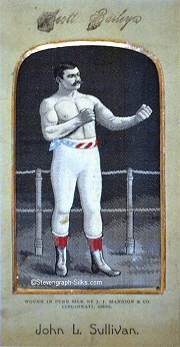
Stevens woven portrait of the American boxer, John L Sullivan, with J J Mannion credit
The Designers
Having mentioned the inventor of the loom, Joseph-Marie Jacquard, and Thomas Stevens, the inventor of the Stevengraph pictures, it is only right to mention the designers employed at the Stevens factory - for the preparation of the basic design is the key to all future processes, and without the pattern and the related punched cards the loom is a useless machine.
One of these key designers was Mr James (Jim) Seckerson. He served his seven-year apprenticeship as a designer with Messrs Owen Bros and joined Thomas Stevens (Coventry) Ltd after the First World War.
In the 1920s and 1930s, Jim Seckerson designed the later Stevengraphs, including the scenic series - Houses of Parliament (the design for this subject was copied from the reverse side of a one-pound note of the period), the Tower of London, Windsor Castle, Warwick Castle - and also the last two portrait silks depicting the new King George VI and Queen Elizabeth (see: so284 and so240).
Apart from these now collectors' pieces, Mr Seckerson designed the more ordinary day-to-day products - the thousands of silk labels which were affixed to almost every garment. And it is interesting to note that he introduced the now common practice of incorporating a representation of the maker's signature in the woven-silk label.
Mr Seckerson's wife and daughter were also employed in the Stevens factory, and other members of the design staff in the 1930s included Leslie Moore, Cyril Smith, George Sterland and James White. Jim's elder brother Walter, 1879-1940, was responsible for stamping, or cutting, the Jacquard cards.
A similar account has been given to me by Mr G. Sterland, who was taken on as one of the last two apprentice designers in 1936:-
Mr Sterland recalls that the Stevengraph works was a two-storey building with a cellar, where the mass of punched cards was kept. Of the designers at that period, this former apprentice tells us that the Seckerson brothers, Walter and James, were the chief designers supported by Messrs Smith, Moore, White and himself.
The method of manufacture was carried out by enlarging the original draft for the design by the use of a 'shadow-graph', or by the 'squaring-off' technique, and this was hand-painted by the designer. These 'blown-up' drafts, which could be anything up to ten feet in length and might take months to complete, were then 'read' on to the cards by a stamping-machine (a piano-like instrument) which made the holes in the cards to correspond with the design.
These cards were finally laced together either by a special type of sewing-machine or by hand. The pierced cards were placed in the cradle of the Jacquard loom, where the punched holes picked out the selected warp and weft to form the pattern - different cards for the various colours.
It is a matter of much personal regret that I am unable to record the names of the earlier designers - those who drew and drafted the charming early Stevengraphs.
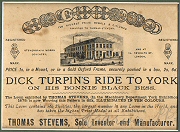
Early back label used by Stevens to advertise available titles
Marketing
To discover the methods employed to sell these Stevengraphs from 1879 to the 1900s has proved rather difficult. Previous writers have stated that they were sold by stationers and booksellers, which is probably true; but it is hardly the whole story.
While announcements and advertisements in the trade magazine The Bookseller would seem to underline this form of retail outlet, these references relate to book-markers - a fairly obvious item for a bookseller to stock. But the decorative Stevengraph pictures did not come into this category. Early in 1968, with the ready co-operation of the editors of the two British trade journals British Stationer and Retail Newsagent, Bookseller and Stationer, I inserted illustrated letters enquiring if any readers had recollections of these silk-woven pictures being stocked. Not one reply was received.
It seems likely that many Stevengraphs were sold direct to the customer, being dispatched by post from the Stevens factory or from the London shop, and some specimens may still be found in their original Stevens printed envelope.
Other Stevengraphs were sold by agents, who doubtless worked on a commission basis , or purchased the silks at the wholesale price of eight shillings a dozen, allowing a 50 per cent profit on cost. Some were apparently private individuals, while others were large firms. Some Stevengraphs were undoubtedly sold by printers, stationers, artists' sundrymen and picture-framers. All these suppositions are based on the following facts:-
- The direct-sale was catered for by the large printed label which was pasted across the back of each card-mount, and which was clearly visible before framing. These labels list the subjects available, with the name and address of the firm at Coventry and the address of their London shop, and on most labels the price is also given.
All this was surely calculated to encourage the buyer of one to purchase further examples from the 'Sole Inventor & Manufacturer'; and, of course, the name also occurs printed on the front of the card-mount, just below the picture. - On the other hand, independent agents in various towns obviously wanted all subsequent orders to be placed with them and not sent direct to the manufacturers. This natural wish is reflected in various back-stamps or written inscriptions found applied to the printed label.
- On a larger scale, we have the printed labels used by 'The Silk Picture Weaving Co' of South Farnborough, Hampshire. A small label is sometimes found pasted on the back of the card-mount on Stevens portrait silks.
An example of c. 1900 reads, after the name-heading:
We have now ready Her Most Gracious Majesty the Queen Woven in
Pure Silk and
neatly
mounted,
Size 7¼ x 5¼Field Marshall Lord Roberts, V.C. General Sir Redvers Buller, V.C. Lord Kitchener of Khartoum General Baden-Powell, the hero of
MafekingA genuine souvenir of England's great struggle in the Transvaal, 1899-1900.
kindly show them to your friends; millions will buy when they see them.
The set post-free 2/6d, all orders dispatched the same day as received.

Typical general interest bookmark made by Stevens - Buy Your Own Cherries

Stevens bookmark designed for the American market - Woven at the The Worlds Columbian Exposition Chicago 1893
The Stevengraph - Silk Bookmarks
Although the book-markers are more fully discussed in Chapter 6, it is relevant to discuss them here briefly for, as I have explained, they were the forerunners of the Stevengraph pictures, and the method of production was the same for all types of these machine-woven objects.
Thomas Stevens had good publicity sense. Not only did he launch the Stevengraphs at an exhibition where the public could witness the looms at work producing the pictures but also, earlier, he was in the habit of sending samples of his book-markers to various magazines and provincial papers, the editors of which were surprisingly agreeable to giving his work publicity.
Some of the earliest of these 'blurbs' were published in The Bookseller, others in the more widely read Art Journal magazine.
A notice in the August 1862 issue of the Art Journal sets the stage for the introduction and popularity of the book-markers - although Thomas Stevens had already registered nine designs at the Patent Office as early as 30 May 1862:
COVENTRY BOOK-MARKERS
We have examined a series of very graceful book-markers, the production of an ingenious manufacturer of Coventry, Mr. Thomas Stevens, which . . . are of high merit, and amply deserve notice. Considerable ingenuity has been exercised in giving an interest to this varied collection; the greater number are for special purposes - prayer-books, for example. Others contain busts of Shakespeare, Byron, etc., others have historic sites, such as the cottage of John Bunyan . . .
To this subject we shall ere long recur, for it is one of much importance - a new branch of art that gives additional employment, where employment is much needed in the ancient and venerable City of Coventry.
The editor of the Art Journal was as good as his word, for the following notice appeared in the January 1863 issue:
BOOK-MARKS
The distress which, unhappily, pervades the Lancashire manufacturing districts, is not limited to that county; the artisans engaged in the silk factories of Coventry are suffering very greatly from a general stagnation of business. An attempt is being made to give employment to these latter, by the production of woven book-marks - many of which that have come before us are exceedingly elegant in design and beautiful in workmanship, quite works of illuminated art. A large demand for these cheap and pretty ornaments would tend to alleviate much distress.
The subsequent public demand was probably not so much attributable to patriotism and the relief of distress amongst the silk workers as to the fact that the book-markers were 'cheap and pretty'. There is also the point that Thomas Stevens issued popular designs, including a series with birthday, Christmas and New Year greetings - subjects that could be sent each year to friends and relations in the same way that we now send birthday and Christmas cards.
The various early subjects available in 1862 were recorded in The Bookseller of 6 December 1862:
The success attending the Coventry book-markers noticed in our number for July last [1862], has induced Mr. Stevens to prepare and issue a new series, which show a marked improvement both in design and in harmony of colours.
Besides those intended for Bibles and Church services, we have others adapted to special occasions, anniversaries, etc., such as 'Bridal Day', 'Xmas', 'New Year's Day', 'Birthday', and 'Love Tokens', etc. We find among them also mementos to Robert Burns, Tributes to Garibaldi; with portraits, etc. . . .
The elegance and taste of these productions must inevitably render them very popular and their manufacture will doubtless increase to such an extent as to become a most important feature of the industry of Coventry. The idea of their production is a happy one and we hope they will obtain that measure of success to which they are justly entitled.
The public's favourable reception of these modest silk strips did indeed alleviate some of the distress amongst the Coventry weavers, spinners and dyers.
As The Bookseller noted in the issue dated 31 January 1863: "Mr. Stevens of Coventry has added to his collection of novel and attractive bookmarkers about a dozen new sorts. . . . Trifling as these may appear we understand that they give employment to more than three hundred of the best weavers of Coventry. . . ." This modest number grew as the popularity of the novelties increased and other manufacturers commenced their production.
Many references from newspapers and journals of the period could be quoted, but it is sufficient to state that the book-markers were extremely successful, thousands upon thousands being sold, paving the way for the introduction of the new mounted Stevengraphs in 1879.
Thomas Stevens claimed to have produced 900 separate designs before 1880, although current research suggests that the actual number of basic bookmark patterns was about half that {for completeness, it should be recorded that the www.Stevengraph-Silks.com web site records more than 800 unique titles - excluding colour variations}.
Over 400 are listed alphabetically in Chapter 6. It must also be remembered that firms other than Thomas Stevens made silk-woven book-markers, often of a standard quite matching the Stevens examples (see Chapter 7). {or again, visit www.Stevengraph-Silks.com web site for extensive alphabetic catalogues of Grant, Bollans, Welch & Lenton etc.}.
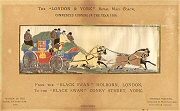
The first Stevengraph picture, woven at the York Exhibition, 1879
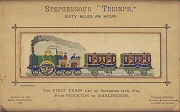
The second Stevengraph picture, woven at the York Exhibition, 1879
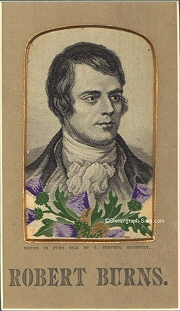
A typical portrait woven in silk by Thomas Stevens - Robert Burns, the Scottish poet
The Stevengraph Silk Pictures & Portraits
Apart from the novelty of the colourful silk-woven pictures, other factors were in Thomas Stevens' favour.
His name was already famous for the tastefully designed silk book-markers which he had been selling in enormous quantities for many years; and of course, through the success of these, he had an already established method of sale for the new pictures. They were after all, in effect, only an adaptation of the book-markers.
With the new pictures the design appeared horizontal instead of upright and the ribbon was stretched across a card-mount with a gilt-lined window, giving a pleasing decorative picture effect.
The interesting and decorative silk-work pictures known as Stevengraphs were first introduced to the public as a gimmick at the York Exhibition which was opened on 7 May 1879 and continued until 31 October.
The first reference that I have been able to trace relating to these charming silk pictures occurs in the June 2 1879 issue of the monthly trade journal The Bookseller. The editorial comment makes interesting reading in this supersonic jet age:
MAILS AND RAILS. Mr. Stevens of Coventry, has produced two interesting 'Stevengraphs' - one the four horse Mail Coach, with the spanking team, doing its twelve miles an hour; the other the Railway Locomotive, doing its sixty or seventy.
These first two Stevengraph pictures - THE LONDON & YORK COACH (or THE GOOD OLD DAYS) and STEPHENSON'S 'TRIUMPH' (or THE PRESENT TIME) - are illustrated in the pane to the left (thumbnail images of those recorded on the web site www.Stevengraph-Silks.com).
Another early subject woven and sold at the York Exhibition in the summer of 1879 was DICK TURPIN'S RIDE TO YORK.
This and the coaching scene were remarked upon in the Yorkshire Gazette of 14 June 1879 in a review of the York Exhibition:
. . . we notice the weaving machines shown at work in the centre of the machinery annexe, by Mr. Thomas Stevens, of Coventry and London, inventor and sole manufacturer of 'Stevengraphs', or illuminated pure silk-woven book-markers, containing the usual variety of verses, texts, etc. At Mr. Stevens loom the visitor has the opportunity of seeing woven beautiful specimens, one portion of the loom being occupied with the weaving, in silk of many colours, a representation of the London and York stage coach on the road in 1706, and another part of the loom at the same time making Dick Turpin appear in full swing on 'Bonny Black Bess'. These are indeed nothing short of works of art, the colouring being richly blended; and a careful observation of the process of manufacture is very interesting. This loom is stated to be the largest in the world and contains 160 shutters . . .
Doubtless many hundreds will avail themselves of the opportunity of securing, at the small price asked, one of the textilographs, or, as they have been called in honour of their originator, 'Stevengraphs', as a souvenir of the Exhibition . . .
'Tall oaks from little acorns grow' - for from the issue of these two silk pictures, made and sold mounted at one shilling each in the 1879 York Exhibition, Thomas Stevens was able to expand the idea and issue Stevengraphs commemorating historical or sporting events, as well as purely decorative pictures and a lengthy gallery of portrait silks.
Messrs Thomas Stevens (Coventry) Ltd made similar silk-work pictures up to the late 1930s and might even now be issuing Stevengraphs commemorating space travel had not the factory been destroyed in the savage German air-raids on the City of Coventry in 1940.
Visitors to the now little-known York Exhibition of 1879 - one of a series of provincial shows imitating the great international exhibitions of the Victorian era - would seem to have eagerly purchased these woven silk mementoes. They were mounted on specially printed card-mounts proclaiming that the picture was woven at the Exhibition, a fact underlined by the special label affixed to the reverse. Even today, over 90 years later, examples bearing these special York Exhibition markings are surprisingly plentiful considering the number that must have been lost or destroyed in the intervening years.
It is quite obvious that the initial sales were very encouraging to Thomas Stevens, who must have seen clearly that he had a winning novelty, for new designs were rapidly produced, initially at the rate of approximately one a month, the first four designs being featured in a Stevens trade advertisement of November 1879.
To return to the story of the mounted silk pictures or Stevengraphs introduced by Thomas Stevens at the York Exhibition in May 1879. As I have stated, the first subjects - THE LONDON & YORK STAGE COACH, STEPHENSON'S 'TRIUMPH', SIXTY MILES AN HOUR and DICK TURPIN'S RIDE TO YORK - were very well received.
During the period of the Exhibition, two new pictures were issued: THE STRUGGLE, the finish of a horse-race (§63) and THE LAST LAP, a penny-farthing bicycle-race (§40), was registered at the Patent Office on the very day that the Exhibition closed, 31 October 1879.
Before the end of the year, three further pictures were issued: FULL CRY (a fox-hunting scene), THE START (a horse-racing scene) and THE FIRST POINT (a coursing scene).
In subsequent years various sporting and historical subjects were introduced, as were an interesting series of portraits. The Stevengraph firm produced at least 70 different designs as well as some 74 portrait subjects, with many more slight variations of the basic designs. For some years into the present century, the popularity of these silks remained - in spite of the fact that many of the subjects were no longer topical and that there was new competition from cheap photographic reproductions of scenes and personalities.
Stevens Heritage
Descendants of Thomas Stevens performed a great service in presenting to the Coventry Museum a superb volume of Stevengraph silks - both book-markers and pictures. These examples, alive with all their original colour, are believed to be the only surviving direct relics of the bombed factory.
I have been informed by Mr Cyril J. Scott, the Curator of the Herbert Art Gallery and Museum at Coventry, that originally two copies of the factory pattern book were kept at the works and that, by chance, on the night of the fateful blitz in November 1940, Mr Henry James Stevens (the nephew of Thomas Stevens) happened to take one of these sets of designs home with him. The family residence was almost unscathed, although the buildings on each side of it were completely destroyed that night.
By this chance act, these factory copies of many of the old Stevens silks were saved; and after Mr Stevens' death, in August 1960, they were attractively mounted in their present volume and presented to the City Museum as a fitting tribute to Henry James Stevens and, indirectly, to Thomas Stevens, the founder of the firm.
Copyright 2015 ©
The extract above are edited quotes directly from Geoffrey Godden's book, Stevengraphs and other Victorian silk pictures, although the order in which the various paragraphs appear differs from his book. The actual copyright © to this publication belongs to Peter Daws, contactable through the web site Stevengraph-Silks.
